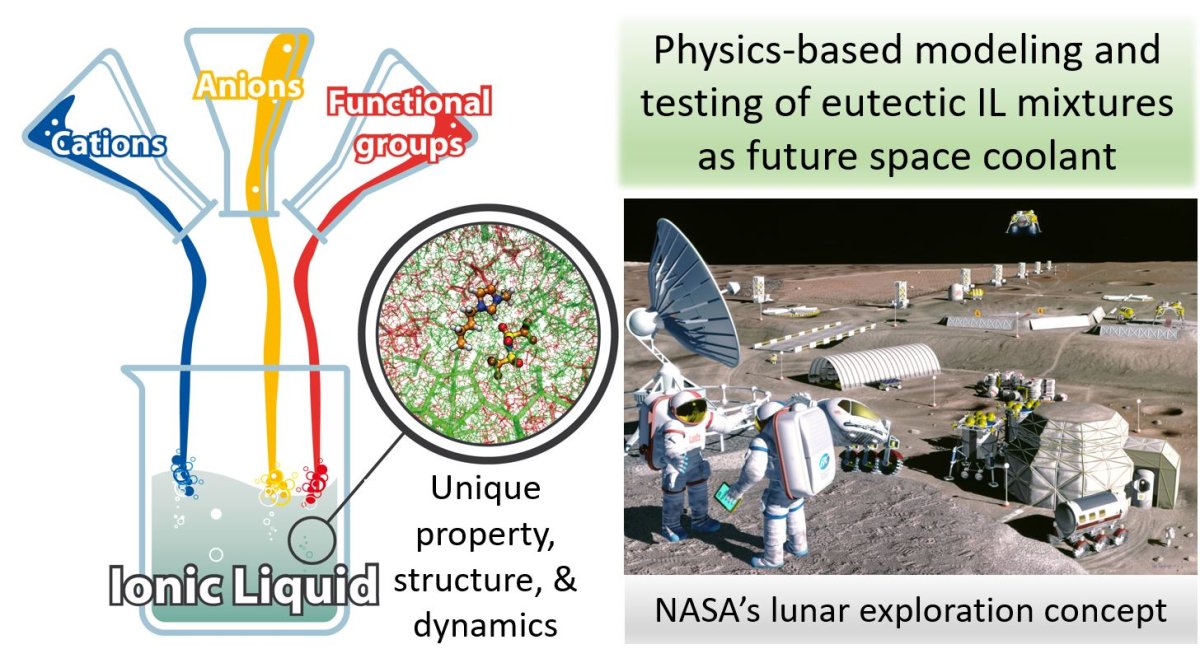Sayan Biswas Receives NASA Early Career Faculty Award

ME Assistant Professor Sayan Biswas recently received the NASA Early Career Faculty Award for his research developing a novel and versatile spacecraft coolant capable of efficient operation in various temperature extremes — a game-changer for future space missions to challenging conditions such as frigid lunar nights, low-power intervals, extended interplanetary journeys, or high-temperature conditions near the sun. The awards recognize groundbreaking work by early career researchers in advanced space technology.
Exploring the Dark Side of the Moon and Jupiter's Moon Europa: The Role of Ionic Liquids in Spacecraft Cooling
Venturing into the far reaches of our solar system, particularly the enigmatic dark side of the Moon and the icy realms of Jupiter's moon Europa, poses unique challenges, one of which is the need for a coolant that can remain liquid at temperatures as low as -150°C and as high as 150°C. Currently, no such coolant exists, but a groundbreaking proposal by Biswas may hold the key to overcoming this hurdle. The solution lies in the world of Ionic Liquids (ILs). "Ionic liquids, a novel category of purely ionic substances resembling salts, emerge as a favorable option for spacecraft cooling due to their potential to maintain a liquid state across a wide temperature span," said Biswas. "Using a physics-based systematic approach, we aim to create suitable tailored ionic liquids and binary or tertiary ionic liquid mixtures to serve as a spacecraft coolant that could simplify spacecraft design and reduce overall system mass, resulting in lower launch costs and increased payload capacity."
Ionic liquids are a class of substances that defy conventional norms by remaining in a liquid state at room temperature as well as hundreds below zero. Composed of ions, which are atoms or molecules carrying an electric charge, these liquids differ from traditional ones like water or organic solvents. Typically comprised of large, asymmetric organic cations (positively charged) and organic or inorganic anions (negatively charged), their unique chemical structure offers a range of properties that make them promising candidates for revolutionizing space coolant applications.
A particularly fascinating aspect of ILs is their ability to exhibit even lower melting points when two or more are mixed, a phenomenon known as a eutectic mixture. However, the challenge lies in identifying the right combination from the countless possibilities. Biswas and his team have devised a multifaceted approach to tackle this complex problem. Their strategy involves synthesizing new ILs, meticulously characterizing their properties, employing machine learning models to create customized IL mixtures with the desired thermal characteristics, and collaborating with external partners to harness the full potential of these remarkable substances for spacecraft thermal management.
The ultimate goal? To identify the ideal IL mixture that will redefine spacecraft cooling, making it a feasible endeavor in the challenging and unforgiving environment of outer space. The project concept is simple, but the execution and steps involved are complex.
Venturing into the far reaches of our solar system, particularly the enigmatic dark side of the Moon and the icy realms of Jupiter's moon Europa, poses unique challenges, one of which is the need for a coolant that can remain liquid at temperatures as low as -150°C and as high as 150°C. Currently, no such coolant exists, but a groundbreaking proposal by Biswas may hold the key to overcoming this hurdle. The solution lies in the world of Ionic Liquids (ILs). "Ionic liquids, a novel category of purely ionic substances resembling salts, emerge as a favorable option for spacecraft cooling due to their potential to maintain a liquid state across a wide temperature span," said Biswas. "Using a physics-based systematic approach, we aim to create suitable tailored ionic liquids and binary or tertiary ionic liquid mixtures to serve as a spacecraft coolant that could simplify spacecraft design and reduce overall system mass, resulting in lower launch costs and increased payload capacity."
Ionic liquids are a class of substances that defy conventional norms by remaining in a liquid state at room temperature as well as hundreds below zero. Composed of ions, which are atoms or molecules carrying an electric charge, these liquids differ from traditional ones like water or organic solvents. Typically comprised of large, asymmetric organic cations (positively charged) and organic or inorganic anions (negatively charged), their unique chemical structure offers a range of properties that make them promising candidates for revolutionizing space coolant applications.
A particularly fascinating aspect of ILs is their ability to exhibit even lower melting points when two or more are mixed, a phenomenon known as a eutectic mixture. However, the challenge lies in identifying the right combination from the countless possibilities. Biswas and his team have devised a multifaceted approach to tackle this complex problem. Their strategy involves synthesizing new ILs, meticulously characterizing their properties, employing machine learning models to create customized IL mixtures with the desired thermal characteristics, and collaborating with external partners to harness the full potential of these remarkable substances for spacecraft thermal management.
The ultimate goal? To identify the ideal IL mixture that will redefine spacecraft cooling, making it a feasible endeavor in the challenging and unforgiving environment of outer space. The project concept is simple, but the execution and steps involved are complex.
